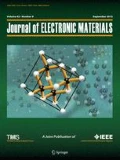Abstract
The effect of different surface finishes, electroless nickel immersion gold (ENIG) and electroless nickel electroless palladium immersion gold (ENEPIG), on the mechanical properties of Sn-58Bi bumps made with solder paste enhanced with epoxy were investigated. The microstructure and fracture surfaces were observed with scanning electron microscopy, and the compositions of the IMC and solder were measured using energy dispersive spectrometry and an electron probe micro-analyzer (EPMA). To evaluate the mechanical properties, low-speed shear tests and board-level drop tests were performed. The result of the shear tests showed that the bonding strength of the epoxy-enhanced Sn-58Bi solder bumps was higher than that of Sn-58Bi solder for all surface finishes, because of the epoxy surrounding the solder, and the fracture surfaces of epoxy-enhanced Sn-58Bi indicated ductile fracture in the solder joint. However, the result of the drop tests showed that samples with the ENIG and ENEPIG surface finishes had lower drop numbers compared to the sample without these surface finishes. The lower performance resulted from insufficient ejection of epoxy from the ENIG and ENEPIG surface finishes during reflow, which reduced the interfacial bonding area.
Similar content being viewed by others
References
Directive 2002/95/EC, The Restriction of the Use of Certain Hazardous Substances in Electrical and Electronic Equipment, The European Parliament and of the Council of the European Union, 27 January 2003.
Directive 2002/96/EC, Waste Electrical and Electronic Equipment (WEEE), The European Parliament and of the Council of the European Union, 27 January 2003.
B. Sandy, E. Briggs, and R. Lasky, Indium Corporation Tech Paper No. 1 (2011). http://www.indium.com/techlibrary/ whitepapers/advantages-of-bismuthbased-alloys-for-low-temperature-pbfree-soldering-and-rework.
J.H. Kim, Y.C. Lee, S.M. Lee, and S.B. Jung, Microelectron. Eng. 120, 77 (2014).
X. Hu, X. Yu, Y. Li, Q. Huang, Y. Liu, and Z. Min, J. Mater. Sci. Mater. Electron. 25, 57 (2014).
J.W. Yoon and S.B. Jung, J. Alloys Compd. 359, 202 (2003).
H. Chen, J. Han, J. Li, and M. Li, Microelectron. Reliab. 52, 1112 (2012).
H.X. Xie and N. Chawla, Microelectron. Reliab. 53, 733 (2013).
S.S. Ha, J.Y. Sung, J.W. Yoon, and S.B. Jung, Microelectron. Eng. 88, 709 (2011).
J.W. Yoon, B.I. Noh, and S.B. Jung, J. Electron. Mater. 40, 1950 (2011).
H.W. Miao and J.G. Duh, Mater. Chem. Phys. 71, 255 (2001).
X.F. Li, F.Q. Zu, H.F. Ding, J. Yu, L.J. Liu, and Y. Xi, Phys. Lett. A 354, 325 (2006).
Q.K. Zhang and Z.F. Zhang, Mater. Sci. Eng. A 528, 2686 (2011).
B.L. Young, J.G. Dug, and G.Y. Jang, J. Electron. Mater. 32, 1463 (2003).
M.S. Suh, C.J. Park, and H.S. Kwon, Surf. Coat. Technol. 200, 3527 (2006).
M.S. Suh, C.J. Park, and H.S. Kwon, Mater. Chem. Phys. 110, 95 (2008).
T. Kotake, H. Murai, S. Takanezawa, M. Miyatake, M. Takekoshi, and M. Ose, CPMT Symposium Japan (ICSJ) (Kyoto, Japan, 2013), pp. 1–4.
J.N. Choi, M.K. Ko, S.M. Lee, and S.B. Jung, J. Microelectron. Packag. Soc. 20, 1 (2013).
K. Suganuma, T. Sakai, K.S. Kim, Y. Takagi, J. Sugimoto, and M. Ueshima, IEEE Trans. Electron. Packag. Man. 25, 257 (2002).
W. Dong, Y. Shi, Z. Xia, Y. Lei, and F. Guo, J. Electron. Mater. 37(7), 982 (2008).
J.S. Hwang, Environment-Friendly Electronics: Lead-Free Technology, Electrochemical Publications, LTD, Isle of Man, Great Britain, 31 Chapters, 2001 (ISBN-0-90-115040-1).
C. Wu, J. Shen, and C. Peng, J. Mater. Sci. Mater. Electron. 23, 14 (2012).
C. Fuchs, T. Schreck, and M. Kaloudis, J. Mater. Sci. 47, 4036 (2012).
S.T. Oh and J.H. Lee, Electron. Mater. Lett. 10(2), 473 (2014).
W.R. Myung, Y. Kim, and S.B. Jung, J. Alloys Compd. 615, S411 (2014).
R. Darveaux and C. Reichman, Electronics Packaging Technology Conference (Singapore, 2006), pp. 283–289.
S.P. Peng, W.H. Wu, C.E. Ho, and Y.M. Huang, J. Alloys Compd. 493, 431 (2010).
P. Snugovsky, P. Arrowsmith, and M. Romansky, J. Electron. Mater. 30(9), 1262 (2001).
D.J. Chakrabarti and D.E. Laughlin, Bull. Alloy Phase Diagr. 5, 148 (1984).
Z. Mei and J.W. Morris Jr., J. Electron. Mater. 21, 599 (1992).
Y. Tanaka, Epoxy Resins Chemistry and Technology, Chapter 2: Synthesis and Characterization of Epoxides (Marcel Dekker, New York, 1988), pp. 54–63.
Acknowledgements
This work was supported by the Human Resources Program in Energy Technology of the Korea Institute of Energy Technology Evaluation and Planning (KETEP) granted financial resource from the Ministry of Trade, Industry & Energy, Republic of Korea (20154030200870).
Author information
Authors and Affiliations
Corresponding author
Rights and permissions
About this article
Cite this article
Myung, WR., Kim, Y. & Jung, SB. Evaluation of the Bondability of the Epoxy-Enhanced Sn-58Bi Solder with ENIG and ENEPIG Surface Finishes. J. Electron. Mater. 44, 4637–4645 (2015). https://doi.org/10.1007/s11664-015-4024-x
Received:
Accepted:
Published:
Issue Date:
DOI: https://doi.org/10.1007/s11664-015-4024-x


